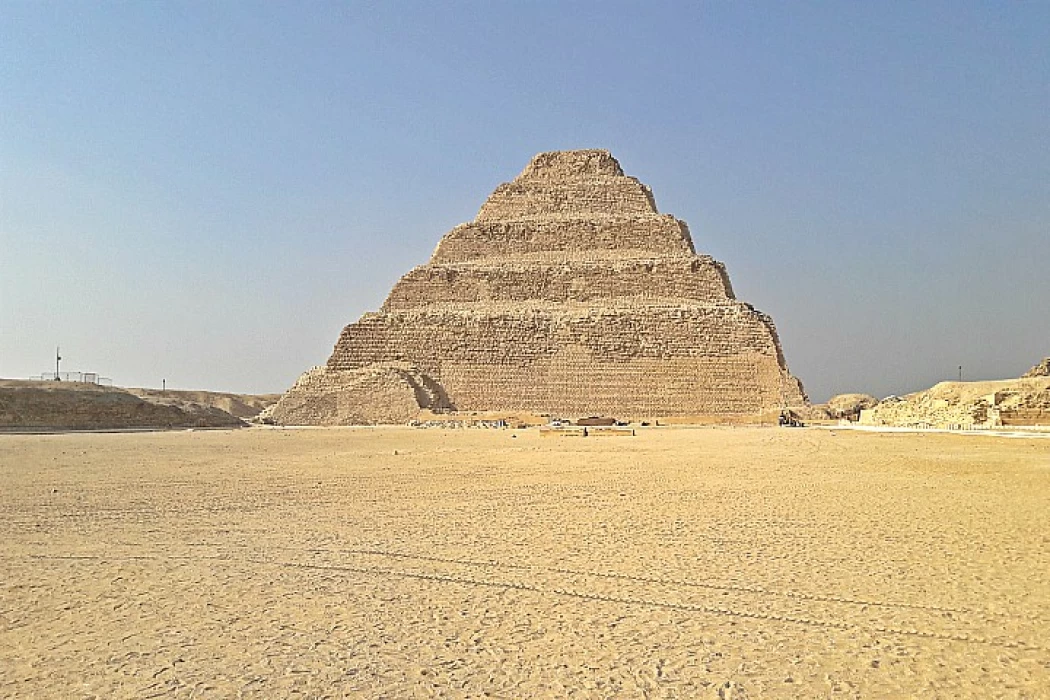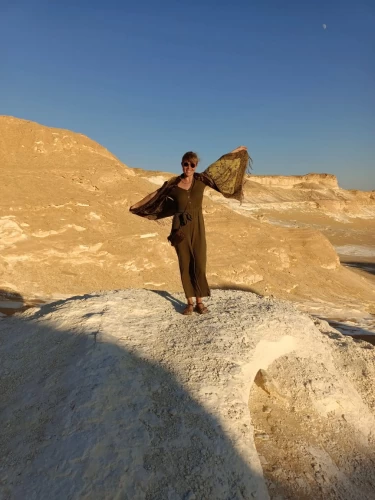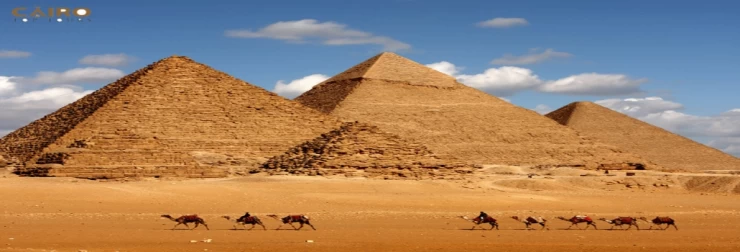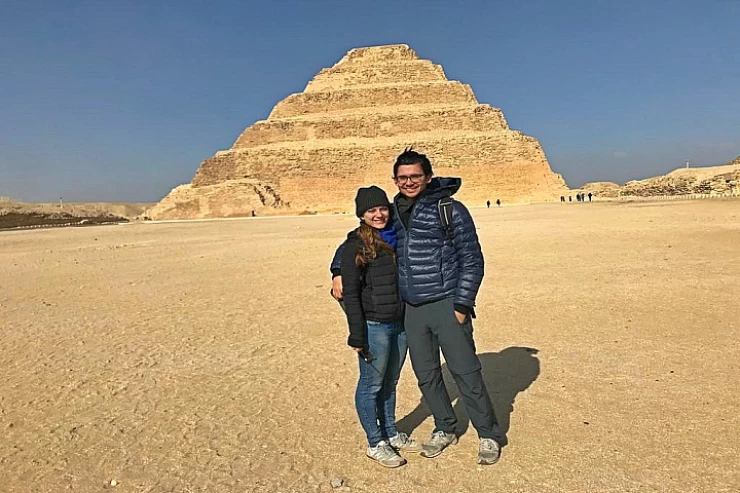La pyramide à degrés et Pyramide de Djoser
La célèbre pyramide à degrés de Sakkara est considérée comme la première sculpture substantielle en pierre au monde. Comme son nom l'indique, il s'agit d'une séquence de six niveaux de pierres de plus en plus petites qui s'élèvent à une hauteur de 62 mètres (200 pieds). Le tremblement de terre de 1992 avait gravement endommagé la structure interne de la pyramide. Pour cette raison, les travaux de restauration ont commencé en 2006 et ont duré 14 ans à travers de nombreuses difficultés. En 2011, les travaux ont subi une interruption en raison de la révolution, ils sont maintenant ouverts aux visiteurs et aux touristes du monde entier.
La pyramide à degrés du roi Djoser à Saqqarah est l'une des les plus importantes choses à faire au Caire ou peut-être dans toute l'Égypte. Cette structure nous montre le développement de la construction pyramidale. C’est la pyramide initiale construite en Égypte et bien que ce ne soit pas une «vraie pyramide» avec des côtés lisses, comme les pyramides de Gizeh et la pyramide pliée et la pyramide rouge de Dahchour.
La première structure en pierre de taille de grande taille au monde se compose de six marches superposées les unes sur les autres. L'architecte de Djoser a décidé d'empiler plusieurs de ces structures pour créer un monument plus imposant au pharaon, qui mesure 203 pieds de haut. Le scientifique le plus célèbre qui doit être mentionné chaque fois que nous parlons de Sakkara est Jean-Philippe Lauer, qui est un archéologue français qui a restauré et reconstruit les parties endommagées du complexe.
Sur le côté Nord de la pyramide, le temple pyramidal est distingué, alors que dans les complexes pyramidaux suivants, il est toujours vu du côté Est. Le complexe de la pyramide à degrés est entouré d'un mur de calcaire de 10,5 m de haut connu sous le nom de façade du palais, qui imite des faisceaux de roseaux liés. La structure globale imite la brique crue. Le mur a 14 fausses portes, mais une seule véritable entrée, dans le coin Sud de la façade Est, est réservée au séjour. Les portes restantes sont connues sous le nom de fausses portes, à l'usage du roi dans l'au-delà.
Ensuite, nous entrons dans le passage couvert de la colonnade avec un plafond en calcaire a été fait de troncs d'arbres entiers conduit à une imitation de pierre massive de deux portes ouvertes, qui était une salle avec vingt paires de colonnes de calcaire construites pour ressembler à des faisceaux de tiges de plantes et atteignant une hauteur de 6,6 m. Les colonnes n'étaient pas autonomes mais étaient fixées aux saillies murales. Entre les colonnes des deux côtés de la salle se trouvaient de petites chambres, qui suggéraient d'être pour chacune des provinces de la Haute et de la Basse Égypte. Au bout de la colonnade se trouvait la salle hypostyle transversale avec huit colonnes reliées par paires par des blocs de calcaire. Il y a des pierres incurvées à l'intérieur du système judiciaire qui sont considérées comme des marqueurs associés au festival Heb-sed, un rituel important accompli par les rois égyptiens lorsqu'ils ont terminé 30 ans pour renouveler leurs pouvoirs.
À l'extrémité Sud de la cour se trouvait une plate-forme approchée par des marches. Il a été recommandé que ce soit un principe pour le double trône. L'ensemble du complexe de la pyramide à degrés symbolise l'enceinte du palais royal et permet au roi d'accomplir les rituels associés à la royauté. Le tombeau était au Sud de la cour très placard Sud.
La chambre funéraire qui ne peut pas être visitée pour le moment pendant les visites du Caire est faite sous un puits profond de 28 mètres de profondeur ainsi que des chambres et galeries creusées reliées à un puits central puis à la salle funéraire du roi, l'enterrement des membres de la famille et le stockage des marchandises et des offres
Des circuits en Egypte remarquables et sûrs ! Avec nos circuits de Pâques en Égypte 2023, vous ressentirez la grâce de l'esprit antique des Égyptiens en explorant les majestueuses pyramides, les temples, les tombeaux qui hantent votre esprit et votre âme tout en bénéficiant du meilleur service. Des meilleures croisières sur le Nil aux forfaits classiques de visites de sites historiques, Cairo Top Tours propose une gamme d'activités et de vacances d'aventure en Égypte. Outre les sites historiques traditionnels, nous proposons une sélection distinctive de safaris dans le désert égyptien à travers le silence magique et l'attrait des Oasis de Siwa, dans le désert égyptien. Choisissez parmi les meilleures offres d'excursions d'une journée en Égypte et choisissez l'une de nos superbes excursions d'une journée au Caire. Nos passionnantes excursions à Louxor et excursions à Assouan vous feront découvrir tous les chefs-d'œuvre historiques de la ville, notamment la fascinante Vallée des Rois, le fantastique temple de la reine Hatchepsout et les temples uniques d'Abu Simble, le tout accompagné d'un guide expert qui vous expliquera l'histoire de ces incroyables sites. Nous vous réservons un accueil indescriptible sur cette terre bénie d'Égypte par l'aide de nos guides qualifies et prés à vous répondre.
Si vous voulez en savoir plus sur la ville de Gizeh et voir à quoi elle ressemble, vous pouvez trouver beaucoup d'informations et de photos sur la ville antique de Bubastis. Vous en apprendrez plus sur Gizeh et sur la façon dont elle a été construite il y a très longtemps.
Si tu veux en savoir plus sur Gizeh et voir à quoi elle ressemble, tu peux trouver beaucoup d'informations et de photos d'un bâtiment spécial appelé la mosquée de Taghri Bardi au Caire. Elle vous en apprendra davantage sur la façon dont Gizeh a été construite il y a très longtemps.
Located in the vast expanses of Saqqara in the outer suburb of Cairo, the Step Pyramid of Djoser is indeed one of the strongest, yet most ancient, structures that Egypt boasts about. Often regarded as the first structure to implement large-scale stone construction techniques, this monumental building can be said to have spearheaded the era of pyramid construction in ancient Egypt. Built over 4600 years ago, the mysterious construction with a wide array of shapes, stories, and usages still exists and inspires archeologists, historians, and tourists to this day.
Historical background and significance
The Step Pyramid, otherwise referred to as the Pyramid of Djoser, was constructed in the 27th century BCE under the reign of the Pharaoh Djoser, who was the second monarch of Egypt's Third Dynasty. Djoser was a progressive king who wanted something more than apostolic vertical graves—mastabas—that man who is into a flat-topped tomb design created for a range of other pharaohs, including his steps. He commissioned the project to his most trusted architect, Imhotep, whom history would remember for far greater things than mere architecture.
Imhotep, who was an architect ahead of his time and the high priest, aspired to build a monument that was not only grand in the eyes of the Pharaoh but would also see a safe flight to Osiris. To achieve this, he invented a new architectural design, which was known as a step pyramid, by vertically stacking six nesting mastabas of increasingly smaller size. This great edifice not only served to elevate the status of Djoser in death but also transformed the architectural landscape of ancient Egypt forever.
The Step Pyramid measures around 62 meters (203 feet) in height, and it was the highest structure back then. Imhotep set a new trend in construction by building the pyramid with stone instead of mudbrick, which was used before. The pyramid is made up of six levels, or steps, each of which rises toward the peak of the structure, forming a staircase that is believed to help the king’s spirit ascend to heaven.
The pyramid complex is quite spacious, covering about 15 hectares (37 acres) and surrounded by a limestone wall with 14 false doors and one real door. This ingenious design had both symbolic and functional value, as it shrouded the pharaoh’s burial place in an aura of mystery and secured him from any invaders. Once inside the enclosure, one can find dozens of different buildings, such as temples and courtyards as well as the South Tomb, all of which are meant to help the deceased king reach the other world as well as serve religious practices.
Impressive underground tunnels form one of the exceptional aspects of the Step Pyramid complex. The vast stretch of 5.7 km (3.5 miles) of these vaults has more than 40, 000 stone jars engraved with the names of other kings before Djoser. The painstaking detail in the arrangement of these tunnels speaks volumes about the ideas of the ancient Egyptians concerning the protection of the treasures of the king for all time.
Imhotep, who came up with the concept of the Step Pyramid, was a Renaissance man qualified in several fields, including architecture, medicine, and religion. Because of his involvement in building the Step Pyramid, he received a lot of fame and respect. He was so influential that he was treated like a god of medical and healing arts more than a century after his death. His innovative way of using stones for construction made way for the enormous pyramids that would come after, such as the Great Pyramid of Giza.
Imhotep's design for the Step Pyramid complex also shows how much he grasps engineering with religion. The superficial step structure of pyramids represents a symbol of ascending toward the gods for the pharaohs, while the inner courtyards and temples are a representation of the cultural aspects of ancient Egyptian society rituals. This ability to balance the need for functional design and altar design envisioning the mass-transforming power of spirits reaffirms his place as one of the best architects in history.
Religious and cultural importance
Step Pyramid is a representation of sacredness in the sense that it is both a tomb and, in this case, a door to another dimension of life. The pharaohs were believed to be the people who could mingle with the gods and, thus, were considered divine. In connection with this, Djoser built the Step Pyramid to protect his divine status as well as ensure that his spirit would traverse safely into other planes of existence.
The course of the pyramid complex construction is accurate in that it shows cardinal directions and contains elements associated with the transport of the great pharaohs. The South Court, which is a large region devoid of any enclosing interior wall, was most likely enlarged in anticipation of the Heb-Sed celebration, which was a ritual that granted legitimacy to the king and spelled his right to rule. This was an opportunity for Djoser to ascertain himself as still living and well, even after he had been buried.
Furthermore, the other enclosing chapels and temples were also built for the priests, who were responsible for conducting the daily ceremonies to the spirit of Djoser, the king, and feeding him for his eternal journey. Such a practice of worshipping the dead in this manner emphasized the unending cycle of life, death, and rebirth, as was the case with the ancient Egyptians, which characterized their way of life.
The Djoser's Step Pyramid laid the foundations for a new generation of pyramids with smooth surfaces that dominated ancient Egyptian architecture. The success of Djoser’s monument brought on the following pharaohs, who commissioned larger and larger pyramids, which resulted in the Giza pyramids.
The Step Pyramid made a few improvements that would later be typical in the design of pyramid complexes. Many of these construction elements—stone quarrying, basement burial chambers, and the giant scale of the structure—were factors that pioneered the development of building pyramids. Djoser’s Step Pyramid is probably the main reason why such enormous pyramids as those of Sneferu, Khufu et al. were constructed.
For many generations, the Step Pyramid remained the symbol of the architectural accomplishment of the ancient Egyptians, but with time, it underwent much erosion. Starting from the year 1900, one British archeologist by the name of Cecil Firth made his way to Saqqara and commenced excavation works, which led to the discovery of most of the structures in the pyramid complex. Over the years, some other excavators have also managed to do a little more work at this remarkable structure.
Recently, however, restoration work has been carried out to restore the Step Pyramid for posterity. The extensive work involves, among other things, the stabilization of the internal chambers and the reconstruction of the outer walls. Such projects thankfully aim to compromise as little as possible on the original purpose of the building and allow this landmark building to testify for even more years about the culture and history of the country.
Visiting the Step Pyramid Today
Currently, tourists visiting Djoser’s Step Pyramid can enjoy not just the structure itself but the entire complex, which also reveals the elements of ancient Egyptian art and religion. Entering through the stone doors and strolling around the open sections, one can almost feel the presence of a bygone era dominated by Kings and the making of everlasting structures.
Nevertheless, Saqqara’s Step Pyramid is also one of the top places to see for every traveler, every historian, and every admirer of the undying civilization of Ancient Egypt. It is a monument of Pharaoh Djoser’s dreams as well as of the genius called Imhotep, the wonder that mankind still looks up to even after 4600 years of its existence.



















